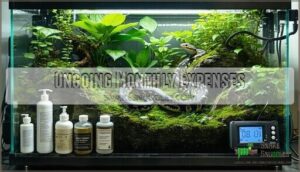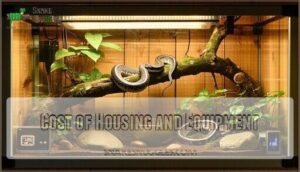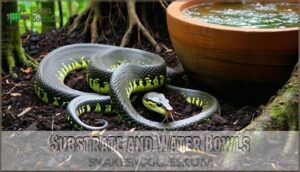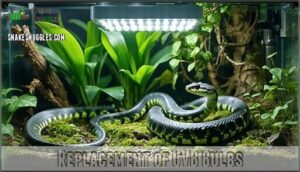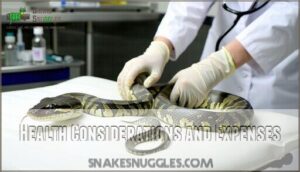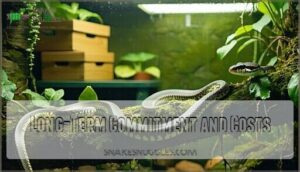This site is supported by our readers. We may earn a commission, at no cost to you, if you purchase through links.
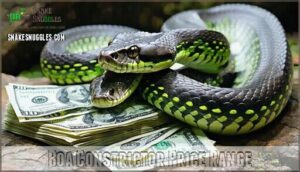
Most people spend $100-$300 for a healthy snake from a breeder or pet store. These prices depend on size, color patterns (morphs), and where you buy.
Don’t forget the extras! A proper enclosure, heating, and other essentials can set you back $300-$500 upfront. Monthly costs for food, cleaning, and maintenance add $50-$100.
It’s rare to break the bank, but planning ahead saves headaches—and maybe your wallet. Curious about balancing costs and care? Exotic pets don’t have to mean exotic costs!
Table Of Contents
- Key Takeaways
- Boa Constrictor Price Range
- Initial Purchase Costs
- Ongoing Monthly Expenses
- Cost of Housing and Equipment
- Care and Maintenance Expenses
- Health Considerations and Expenses
- Long-Term Commitment and Costs
- Frequently Asked Questions (FAQs)
- How much do boa constrictors cost?
- Are boa constrictors a good pet snake?
- Do boa constrictors poop?
- Where can I buy a used boa?
- What are the disadvantages of buying a used boa?
- How do I care for an adult boa?
- Is a boa constrictor rare?
- Is a boa snake a good pet?
- Where can I buy boa constrictors?
- How much does a boa constrictor snake cost?
- Conclusion
Key Takeaways
- You can buy a boa constrictor for as little as $50, but rare morphs can cost thousands—know your budget and priorities.
- Setting up a proper enclosure, including heating and lighting, costs $300–$500 upfront, so plan ahead.
- Regular monthly expenses, including food, cleaning, and maintenance, average $50–$100, making boas affordable to keep.
- Captive-bred boas from reputable breeders are safer and more reliable, though rescues offer cheaper adoption fees of $25–$75.
Boa Constrictor Price Range
If you’re thinking about getting a boa constrictor, their price can range from affordable to a serious splurge.
The cost mostly depends on their type, age, and how rare their morph is—some even go for thousands!
Rare boa morphs can reach jaw-dropping prices, with some fetching thousands due to their unique patterns and genetics.
Factors Affecting Price
The boa constrictor price range depends on several key factors.
Age and size impact costs—baby boas are usually cheaper, while adults fetch higher prices.
Curious why prices swing so much? Check these out:
- Morph Rarity: Rare or exotic boa constrictor morph costs can skyrocket due to unique patterns and colors.
- Genetic Lineage: Breeders charge more for snakes with standout genetics or designer traits.
- Captive Bred vs. Wild-Caught: Captive boas, with known health and feeding history, are pricier but safer.
Beyond the initial purchase, remember to factor in long-term enclosure upkeep.
In short, a snake’s market demand, breeder reputation, and quality all shape the final cost!
Types of Boa Constrictors
When choosing from the types of boas, the options are exciting.
Locality boas like the Colombian stand out with their 10-foot size and reddish patterns, while dwarf boas, such as Brazilian rainbow boas, glow under light with their 6-foot frames and iridescent scales.
Morph variations, hybrid boas, and genetic lineage influence boa constrictor morph costs, making every boa morph price unique within the boa constrictor price range.
Rare and Exotic Morphs
Rare and exotic boa morphs are the superstars of snake enthusiasts.
Rare and exotic boa morphs captivate collectors, blending stunning colors with unique patterns that transform them into living works of art.
Their stunning patterns and unique colors stem from careful genetic breeding. These designer morphs pack wow-factor—and hefty price tags. Expect to spend $1,000 or more for top-tier boas.
Here’s why prices vary:
- Morph Genetics: Uncommon traits boost value.
- Demand and Investment Potential: Collectors often drive prices up.
- Ethical Breeding: Quality care costs more.
- Rarity: Less availability equals steeper costs.
Initial Purchase Costs
When buying your first boa constrictor, you’ll find prices vary a lot depending on genetics and where you shop.
Common boas cost as little as $50, but rare morphs can set you back thousands.
Buying From Breeders
Wondering where to get a boa? Breeders are the gold standard for captive-bred snakes.
Their expertise guarantees health guarantees, proper care, and ethical sourcing. Prices for normal boa morphs typically range $50–$150, depending on lineage.
Always check the snake breeder reputation for transparency and genetic diversity. A great breeder is like a tailor—crafting the perfect fit for your needs while prioritizing the snake’s welfare.
It’s worth every penny!
Adopting From Rescues
Thinking about rehoming a snake? Adopting from a rescue is often affordable, with adoption fees ranging from $25 to $75.
You’ll support ethical adoption while providing a shelter boa with a fresh start. Rescues assess temperament and guarantee health, so you’ll know your pet’s history beforehand.
Plus, joining a rescue network offers advice and guidance from fellow reptile lovers. It’s a budget-friendly way to guarantee a safe and supported boa experience!
Pet Store Prices
Pet stores often offer boa constrictors at higher reptile prices than breeders.
A common boa might cost $150–$300, while rare boa morphs skyrocket into the thousands.
Be cautious—a shiny storefront doesn’t equal healthy snakes.
Many lack health guarantees or clear sourcing practices.
Beginner packages can seem tempting, but impulse buys could lead to regret.
Reputable online reptile stores offer a wider selection.
Research store reputation thoroughly before jumping in.
Reliable breeders typically deliver better value and can provide a more transparent buying experience, making them a good choice for those looking for a pet snake.
Ongoing Monthly Expenses
You’ll find that owning a boa constrictor comes with some regular costs to keep it healthy and comfortable.
From food and vet visits to cleaning supplies and temperature control, these expenses can add up, but they’re essential for your snake’s care.
Food and Feeding
Feeding your boa constrictor doesn’t have to be tricky, but it’s important to get it right.
These carnivores thrive on frozen rodents like mice and rats, which cost $10–$60 per month. Stick to prey items that match your snake’s girth to avoid obesity risks. Aim for proper feeding frequency—too often, and your boa could get chunky.
Many owners source their frozen reptile food online for convenience.
Here’s what to know:
- Frozen vs. live prey: Frozen is safer for your snake.
- Defrosting tips: Warm prey using hot water, not microwaves.
- Prey size: Match it to your boa’s widest point.
- Supplementation: Supplements aren’t typically necessary.
Veterinary Care
Finding a good exotic vet is key for your boa’s health. Annual check-ups cost $50-$100 and help with preventive care like parasite control.
Emergency costs can climb to $500 or more, so have a budget ready. Exotic pet health insurance might help cover surprises, though it’s not cheap.
Consider browsing boa vet supplies for potential at-home care options. Regular snake veterinary care can catch issues early, saving you stress—and your boa from curling up with serious health problems later.
Environmental Maintenance
Keeping your boa’s habitat cozy requires regular environmental maintenance.
Here’s what to expect each month:
- Substrate Options: Swap out bedding for $10–$20. Choose coconut husk or cypress mulch for comfort and cleanliness.
- Enclosure Cleaning: Stock up on cleaning supplies ($5–$10) to handle messes. Keeping things squeaky clean prevents health issues.
- Humidity Levels: Maintain healthy air with $5–$10 for humidity control. A hygrometer helps regulate moisture.
- Temperature Gradients: Spend $15–$30 on heating and lighting, like thermostat-controlled UVB bulbs.
Better care means a healthier, happier boa! Many owners also consider suitable bedding choices for their boa.
Pet Insurance
Not everyone knows you can get pet insurance for your boa constrictor.
It’s like giving your snake a safety net for unexpected vet visits—without breaking the bank.
Here’s a quick comparison of common plans:
| Plan | Monthly Cost | Annual Limit |
|---|---|---|
| Basic | $15–$25 | $1,000 |
| Standard | $25–$40 | $5,000 |
| Premium | $40–$60 | $10,000 |
| Wellness Add-on | $10–$20 | Varies |
Policies differ by coverage options and costs—check exclusions carefully to avoid surprises!
Cost of Housing and Equipment
Housing your boa constrictor properly isn’t cheap, but it’s worth every penny to keep your snake healthy and happy.
From a large enclosure to heating, lighting, and supplies, expect to spend around $300 to $700 upfront.
Enclosure Size and Type
Your boa’s home isn’t just a tank—it’s their castle, and size matters! A spacious enclosure like a 4′ x 2′ x 4′ terrarium (or bigger) lets them thrive.
Build or buy, but remember these key tips:
- Enclosure Dimensions: Plan for their adult size. Bigger is always better.
- Material Choices: Durable enclosures like PVC or wood last longer.
- Ventilation Needs: Proper airflow keeps humidity in check.
- Security Features: Tight locks prevent escapes.
Invest in their comfort—you’ll thank yourself later!
Heating and Lighting
Heat and light are critical for your boa’s health.
Set the right temperature with a basking lamp ($20-$30), UVB bulb ($30-$50), and a thermostat ($30-$50).
Here’s a quick breakdown:
| Item | Purpose | Cost Range |
|---|---|---|
| Basking Lamps | Warm basking spot | $20-$30 |
| UVB Bulbs | UVB importance | $30-$50 |
| Thermostats | Temperature control | $30-$50 |
Automation systems help save effort, while nighttime heat guarantees comfort.
Substrate and Water Bowls
Your boa’s floor matters just as much as its heat source!
Opt for cypress mulch, coconut husk, or aspen shavings.
Substrate costs $20–$40, while proper water bowls, essential for hydration, vary.
Choose sturdy, spill-proof bowls sized for your boa.
Clean regularly to maintain water quality, control humidity, and enhance the habitat’s enrichment value.
Happy boa, happy you!
Care and Maintenance Expenses
Taking care of a boa constrictor isn’t just about feeding; you’ll need to budget for cleaning supplies, UVB bulbs, and maintaining proper humidity and temperature.
These costs add up over time, but they’re essential for keeping your snake healthy and happy.
Replacement of UVB Bulbs
Your boa’s UVB lighting is like their personal sunshine—it’s essential for health! Unfortunately, UVB bulbs have a limited lifespan and need replacing.
Here’s how to keep their habitat glowing:
- Stick to a bulb-changing schedule: replace every 6-12 months to prevent UVB degradation.
- Use trusted reptile brands for accurate UVB spectrum coverage.
- Keep bulbs 12-18 inches above the basking spot for ideal placement.
- Don’t mix UVB and heating bulbs; each has its own job!
A healthy snake starts with solid lighting.
Cleaning Supplies
Cleaning your boa’s enclosure isn’t glamorous, but it’s vital! Use snakesafe cleaning supplies like gentle disinfectants, biodegradable wipes, and a solid scrub brush.
For extra savings, try DIY solutions—just verify they’re snake-friendly. Clean regularly to prevent odor buildup and maintain health.
Routine care avoids costly vet bills later!
Humidity and Temperature Control
Creating the perfect tropical vibe for your boa isn’t hard, but it does take some planning. Humidity and temperature control are key to their happiness, so aim for the right balance.
Here’s how to keep things just right:
- Humidity Monitoring: Keep levels between 50-70%. Too low? Add moss. Too high? Boost ventilation.
- Ideal Gradient: Maintain 88-92°F on the warm side and 78-82°F on the cool side.
- Thermostat Accuracy: Use a thermostat to prevent overheating or drops.
- Heat Lamp or Mat: Pick a reliable heating option for steady warmth.
- Seasonal Adjustments: Adjust for colder months to avoid shedding issues.
Use an infrared thermometer to double-check temperatures. Steady climate, happy boa!
Health Considerations and Expenses
Keeping your boa healthy isn’t just about feeding it frozen rodents—it’s also about handling unexpected vet bills.
From respiratory infections to annual check-ups, you’ll need to be ready for costs that keep your slithery friend in top shape.
Common Health Issues
Sometimes, snakes hit a rough patch with common health issues like respiratory infections, shedding problems, or parasites.
It’s smart to spot these early—think of it as catching a leaky faucet before it floods! Keep an exotic vet on speed dial for emergencies or preventative checkups.
Watch out for snake skin infections or regurgitation after meals, which could signal trouble.
Here’s a quick guide:
| Issue | Signs | Solution |
|---|---|---|
| Respiratory Infections | Wheezing, mucus | Vet treatment, warmth |
| Parasites | Lethargy, weight loss | Parasite prevention meds |
| Shedding Problems | Stuck skin, dullness | Proper humidity levels |
| Skin Infections | Red spots, swelling | Disinfectant, vet help |
| Regurgitation | Lost meals | Check temps, feeding gaps |
Emergency Vet Visits
Emergencies happen, even for snakes. A veterinary emergency like a respiratory infection or scale rot can cost $100 to $500 at an exotic vet.
Recognizing symptoms, such as wheezing or unusual skin changes, is key. Always have an emergency fund and a snake first aid kit ready.
Transporting snakes safely in a secure container is essential for treatment. Remember that prolapse requires immediate attention, so be vigilant for this symptom.
Think of it as a health insurance policy for your slithery friend, and having a plan in place can help mitigate the effects of a veterinary emergency.
Preventative Care
Annual checkups are your boa’s best health insurance.
A quick veterinary visit can catch issues like respiratory infections early.
Here’s how to keep your snake thriving:
- Parasite control: Regular exams help prevent infestations.
- Shedding issues: Proper husbandry practices avoid stuck skin.
- Respiratory health: Maintain humidity and temperature to dodge problems.
Staying proactive means fewer emergencies and a happier, healthier boa for years.
Long-Term Commitment and Costs
Owning a boa constrictor is a long-term commitment since these snakes can live 20 to 30 years or more.
You’ll need to budget for their growing size, larger enclosures, and ongoing care to keep them healthy and comfortable.
Adult Size and Space Requirements
Adult boa constrictors can reach lengths of 8–10 feet, so an enclosure measuring 8′ x 4′ x 4′ is a must.
Invest in strong custom terrariums to handle their growth rate. Use space enrichment like climbing branches and hides to mimic natural habitats.
To maintain their well-being, consider proper ventilation systems to guarantee fresh air circulation. Keeping the right enclosure dimensions guarantees comfort, reduces handling challenges, and keeps your boa healthy and stress-free.
Lifespan and Aging
When planning for a boa constrictor, their impressive lifespan—often 20–30 years—means you’re in it for the long haul!
Aging brings unique needs, so keep these key points in mind:
- Longevity factors: Proper care, like consistent heat and humidity, maximizes your boa’s lifespan.
- Aging signs: Slower shedding and reduced appetite are common as they grow older.
- Geriatric care: Older boas may need gentler handling and less frequent feeding.
- Health challenges: Watch for joint stiffness or organ issues during their golden years.
Ongoing Care and Maintenance
Taking care of a boa constrictor feels like managing a low-maintenance but particular roommate. They’re not demanding, but they do need consistent attention. Think of your boa’s needs as a mix of basics and perks.
Weekly enclosure cleaning ($10–$20/month) keeps things fresh. Feeding every 1–2 weeks costs $30–$60/month, depending on your snake’s size. Substrates need replacing monthly ($15–$30). Daily humidity control, vital for shedding assistance and comfort, runs about $5–$10/month.
Add annual vet check-ups ($50–$100/year) and consider pet insurance for surprise health care costs. Beyond the numbers, focus on enrichment needs like climbing branches and regular handling to stay in tune with its temperament changes.
When traveling, plan care ahead. Monthly costs vary, but staying proactive guarantees a calm, healthy boa.
Frequently Asked Questions (FAQs)
How much do boa constrictors cost?
Boa constrictors usually cost $50 to $150 for common morphs, while rarer ones can hit thousands.
Rescues often charge $25 to $
Factor in setup costs, too—it’s not just the snake you’re buying!
Are boa constrictors a good pet snake?
Measure twice, cut once" applies here—boa constrictors can be great pets if you’re prepared.
They’re fascinating, long-lived, and manageable with proper care, but their size and needs make them a better fit for experienced keepers.
Their care requires attention to detail, and understanding their needs is crucial for a successful pet-keeper experience.
Do boa constrictors poop?
Yes, they do!
Boa constrictors poop just like any other animal.
Expect a solid waste mix that looks like firm, dark matter and white urates.
Trust me, it’s a normal part of snake care!
Where can I buy a used boa?
Buying a used boa is like treasure hunting—you can check reptile rescues, online forums, or local classifieds.
Make certain it’s healthy, captive-bred, and the seller provides a clear history.
Ask plenty of questions!
What are the disadvantages of buying a used boa?
Buying a used boa can mean hidden health issues, incomplete feeding histories, or poor handling habits.
Plus, you might inherit someone else’s neglect.
If you’re up for the challenge, be ready for surprises—and extra vet visits!
How do I care for an adult boa?
Caring for an adult boa isn’t rocket science, but it’s no walk in the park either.
Keep their enclosure warm, humid, and escape-proof.
Feed appropriately sized prey, handle regularly, and monitor their health closely.
Is a boa constrictor rare?
Boa constrictors aren’t rare, but some morphs or subspecies can be harder to find.
While “normal” boas are common, rare traits like albino or sunglow morphs fetch higher prices.
It’s all about genetics!
Is a boa snake a good pet?
Big boa snakes bring bold responsibility.
They can be great pets if you’ve got the space, patience, and knowledge.
With the right care, they’ll thrive, but their size and lifespan aren’t for casual keepers.
Where can I buy boa constrictors?
You can find boa constrictors through reputable breeders, exotic pet stores, and rescues.
Always check for captive-bred snakes.
Online forums also connect buyers with breeders, but research thoroughly to avoid sketchy deals or illegal practices, and look for reputable sources.
How much does a boa constrictor snake cost?
You know what they say, "You get what you pay for!"
A boa constrictor can cost $50 to $5,000 depending on its morph, size, and rarity.
Expect additional setup and care expenses too.
Conclusion
Owning a boa constrictor is both thrilling and affordable—if you plan wisely.
The boa constrictor price range varies from budget-friendly to exclusive, depending on morphs and sources.
While the snake itself mightn’t break the bank, the upfront costs for enclosures, heating, and maintenance can add up.
Long-term, the monthly expenses stay manageable with proper care.
By balancing costs and care, you’ll enjoy a rewarding adventure without draining your wallet.
Exotic pets don’t have to mean exotic expenses, and with the right approach, you can have a thrilling experience.
- https://www.petsmart.com/
- https://binkybunny.com/forums/topic/my-youngest-rabbit-started-to-eat-her-aspen-shavings-and-doesnt-like-to-use-litterbox-with-itae/
- https://community.morphmarket.com/t/is-orangasm-a-line-of-something/14501
- https://www.quora.com/Looking-to-buy-a-Central-American-boa-but-would-prefer-a-small-one-How-can-I-assure-the-boa-will-be-no-bigger-than-6-feet-as-there-is-conflicting-information-online-about-them
- https://animaldiversity.org/accounts/Boa_constrictor/


